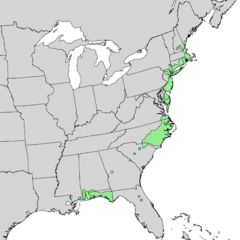Chamaecyparis thyoides
| Chamaecyparis thyoides | |
|---|---|
 | |
| Foliage and cones | |
| Conservation status | |
| Scientific classification | |
| Kingdom: | Plantae |
| Division: | Pinophyta |
| Class: | Pinopsida |
| Order: | Pinales |
| Family: | Cupressaceae |
| Genus: | Chamaecyparis |
| Species: | C. thyoides |
| Binomial name | |
| Chamaecyparis thyoides (L.) Britton, Sterns & Poggenb. | |
 | |
| Natural range of Chamaecyparis thyoides | |

Chamaecyparis thyoides (Atlantic white cedar, Atlantic white cypress, or whitecedar falsecypress), is a species of Chamaecyparis, native to the Atlantic coast of North America from Maine south to Georgia, with a disjunct population on the Gulf of Mexico coast from Florida to Mississippi. It grows on wet sites on the coastal plain at altitudes from sea level up to 50 m, more rarely in the foothills of the Appalachian Mountains up to 460 m altitude.[2]<ref =grin>Germplasm Resources Information Network: Chamaecyparis thyoides</ref>

It is an evergreen coniferous tree growing to 20–28 m (rarely to 35 m) tall, with feathery foliage in moderately flattened sprays, green to glaucous blue-green in color. The leaves are scale-like, 2–4 mm long, and produced in opposite decussate pairs on somewhat flattened shoots; seedlings up to a year old have needle-like leaves. The seed cones are globose, 4–9 mm diameter, with 6-10 scales, green or purple, maturing brown in 5–7 months after pollination. The pollen cones are purple or brown, 1.5–3 mm long and 1–2 mm broad, releasing their yellow pollen in spring.[2][3]

There are two geographically isolated subspecies, treated by some botanists as distinct species, by others at just varietal rank:[2][3]
- Chamaecyparis thyoides subsp. thyoides (Atlantic white cedar). Atlantic coast, Maine to Georgia. Leaves and cones usually glaucous blue-green; facial leaves flat, not ridged; cones 4–7 mm long. (Least concern)
- Chamaecyparis thyoides subsp. henryae (H.L.Li) E.Murray (Gulf white cedar; syn. Chamaecyparis thyoides subsp. henryae (H.L.Li) Little; Chamaecyparis henryae H.L.Li). Mexican Gulf coast, Florida to Mississippi. Leaves and cones always green, not glaucous; facial leaves with a longitudinal ridge; cones 6–9 mm long. (Near threatened)
Older gypsy moth caterpillars sometimes eat the foliage, whereas young ones will avoid it.
Cultivation and uses
Chamaecyparis thyoides is of some importance in horticulture, with several cultivars of varying crown shape, growth rates and foliage color having been selected for garden planting. Named cultivars include 'Andelyensis' (dwarf, with dense foliage), 'Ericoides' (juvenile foliage), and 'Glauca' (strongly glaucous foliage).[3] The wood is reported to endure moisture indefinitely; it has been used for fence-posts, ties and shingles.[4]
References
| Wikimedia Commons has media related to Chamaecyparis thyoides. |
- ↑ Conifer Specialist Group (1998). Chamaecyparis thyoides. 2006. IUCN Red List of Threatened Species. IUCN 2006. www.iucnredlist.org. Retrieved on 12 May 2006.
- ↑ 2.0 2.1 2.2 Farjon, A. (2005). Monograph of Cupressaceae and Sciadopitys. Royal Botanic Gardens, Kew. ISBN 1-84246-068-4
- ↑ 3.0 3.1 3.2 Rushforth, K. (1987). Conifers. Helm ISBN 0-7470-2801-X.
- ↑ Peattie, Donald Culross. Trees You Want to Know. Whitman Publishing Company, Racine, Wisconsin, 1934 p31
